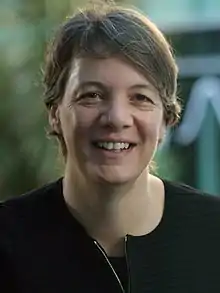Michelle Yvonne Simmons
Michelle Yvonne Simmons AO (* 14. Juli 1967 in London) ist eine australische Professorin für Quantenphysik und Direktorin des Centre of Excellence for Quantum Computer Technology an der University of New South Wales.[1] Sie gilt als Pionierin der Quantenrechnung.[2]

Werdegang
In den 1990ern arbeitete Simmons als Research Fellow in Quantenelektronik bei Michael Pepper am Cavendish-Laboratorium, wo sie für die Entdeckung des 0,7 G-Plateaus beim Quantenpunktkontakt[3] und die Entwicklung von 1-Loch-Transistoren international bekannt wurde.[4] 1999 erhielt sie eine Queen Elisabeth II Fellowship und ging nach Australien. Sie ist ein Gründungsmitglied des Centre of Excellence for Quantum Computer Technology.[1]
Errungenschaften
Ab 2000 etablierte Simmons eine große Forschungsgruppe zur Entwicklung atomarer Bauelemente in Silicium und Germanium. Ihre Forschungsgruppe entwickelte den ersten atomaren Transistor mit einer Genauigkeit von 1 nm.[5][6][7]
Simmons hat mehr als 350 Artikel in wissenschaftlichen Zeitschriften publiziert und ein Buch über Nanotechnologie geschrieben.[8] Sie besitzt vier Patente.[9]
Auszeichnungen
2005 erhielt Simmons die Pawsey Medal der Australian Academy of Science und wurde 2006 einer der jüngsten Fellows der Akademie.[10] 2011 war sie NSW Scientist of the Year.[11] 2014 wurde sie in die American Academy of Arts and Sciences aufgenommen.[12] 2015 erhielt sie den Australian Eureka Prize for Leadership in Science[13] und die Thomas Ranken Lyle Medal.[14][15] Ebenfalls für 2015 wurde ihr der Feynman Prize in Nanotechnology zugesprochen, für 2017 der UNESCO-L’Oréal-Preis. Seit 2015 ist sie Fellow der American Association for the Advancement of Science,[16] seit 2018 Mitglied der Royal Society. Simmons wurde als Bakerian Lecturer 2022 ausgewählt.
Weblinks
Einzelnachweise
- Quantum Computing – Centre for Quantum Computation and Communication Technology: Biography.
- Quantum physicist – Michelle Simmons. Australian Broadcasting Corporation, 28. Februar 2012, abgerufen am 25. Januar 2016.
- K. J. Thomas, J. T. Nicholls, M. Y. Simmons, M. Pepper, D. R. Mace: Possible Spin Polarization in a One-Dimensional Electron Gas. In: Physical Review Letters. Band 77, Nr. 1, Juli 1996, S. 135–138, doi:10.1103/PhysRevLett.77.135.
- Hugh D. Young, Roger A. Freedman, Ragbir Bhathal (Hrsg.): University Physics: Australian edition. Pearson Australia; 2010, ISBN 978-1-4425-1711-0, S. XIV
- Andreas Stiller: Neue Rekorde beim Quantencomputing auf Siliziumbasis. Heise online, 16. September 2014, abgerufen am 28. Januar 2016.
- Martin Fuechsle, Jill A. Miwa, Suddhasatta Mahapatra, Hoon Ryu, Sunhee Lee: A single-atom transistor. In: Nature Nanotechnology. Band 7, Nr. 4, April 2012, S. 242–246, doi:10.1038/nnano.2012.21.
- Narrowest conducting wires in silicon ever made show the same current capability as copper. auf phys.org, 5. Januar 2012.
- Selected publications by Scientia Professor Michelle Yvonne Simmons. UNSW, abgerufen am 28. Januar 2016.
- Select Publications: Patents. (University of New South Wales)
- Chief Executive Women: Michelle Simmons. CEW, abgerufen am 28. Januar 2016.
- Honour Roll NSW Science & Engineering Awards: 2008-2014. Office of the NSW Chief Scientist and Engineer, abgerufen am 28. Januar 2016.
- Fellow and Pawsey Medalist receives top US honour. Australian Academy of Science, 25. April 2014, abgerufen am 28. Januar 2016.
- Honours and awards to Fellows. Australian Academy of Science, 1. September 2015, abgerufen am 28. Januar 2016.
- 2015 Thomas Ranken Lyle Medal for research in mathematics or physics. Australian Academy of Science, abgerufen am 28. Januar 2016.
- Australian Research Council Annual Report 2014-15, S. 22 & 220
- UNSW researcher joins the honour roll of the world’s best scientists. In: unsw.edu.au. Abgerufen am 3. September 2021 (englisch).